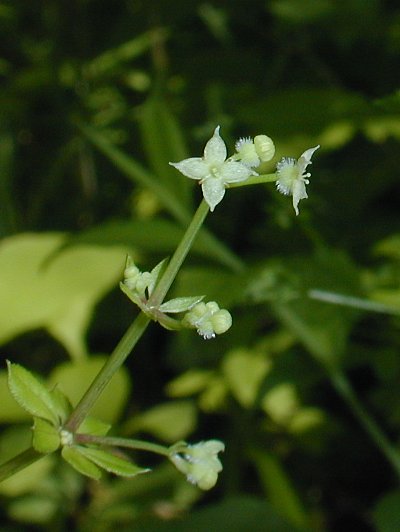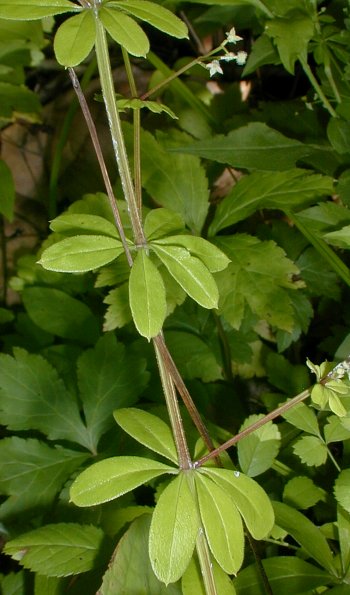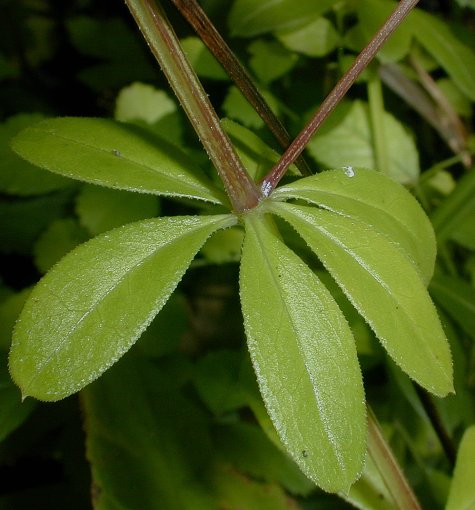Description: This herbaceous perennial plant is 1-3' tall, branching occasionally. The slender stems have a tendency to sprawl; they are light green to reddish green, angular, and strongly ridged. Usually, there are a few short hairs that provide the stems with a slightly rough texture. At intervals along the stems, there are whorls of 6 sessile leaves. These leaves are up to 2½" long and ½" across; they are oblanceolate in shape, while their margins are smooth and ciliate. Each leaf abruptly tapers to a short pointed tip (cuspidate). Occasionally, 1-3 stalks of flowers develop from the middle to upper whorled leaves; these stalks are often longer than the leaves, and they can be axillary or terminal. Each of these stalks may produce 1-3 flowers on slender pedicels.

Each flower spans
about 1/6" (4.5 mm.) across, consisting of 4 greenish white to white
petals, 4 stamens, and a bristly 2-celled ovary. Each petal tapers to a
narrow tip. The blooming period occurs during the summer for about 2
months. Each flower is replaced by a bristly 2-celled carpel; each
globoid cell contains a single small seed. The cells of the carpel
eventually separate. The root system produces rhizomes. This plant can
spread by reseeding itself, or by forming vegetative offshoots from the
rhizomes.
Cultivation:
The preference is light shade to partial sun, moist conditions, and a
fertile loamy soil.

Range &
Habitat:
The native Sweet-Scented Bedstraw occurs in most areas of Illinois,
where it is
occasional to locally common (see Distribution
Map). Habitats include moist to mesic deciduous woodlands,
rocky bluffs, areas along woodland paths, thickets, moist meadows,
partially shaded seeps and springs, partially shaded riverbanks, and
bogs. In badly degraded woodlands, this plant is replaced by Galium
aparine (Cleavers).
Faunal Associations:
The flowers are occasionally visited by small bees or flies; these
insects usually suck nectar. The caterpillars of several moths feed
on Galium spp. (Bedstraws), including Lobocleta
ossularia (Drab Brown Wave), Epirrhoe alternata
(White-Banded Toothed Carpet), and Hyles
gallii (Galium Sphinx). Other insect feeders include
larvae of Dasineura
americana (Bedstraw Midge), larvae of the sawfly Halidamia affinis,
and the polyphagous aphid Abstrusomyzus
phloxae. Deer usually leave the foliage alone. The bristly
carpels of
Sweet-Scented Bedstraw can cling to the fur of animals and the clothing
of humans; by this means, the seeds are distributed to new locations.

Photographic
Location:
Along a woodland path in a moist area of Busey Woods in Urbana,
Illinois.
Comments:
The common name refers to the vanilla scent of the dried foliage.
Sweet-Scented Bedstraw is typically found in moist woodlands. It can be
distinguished from other Galium spp. (Bedstraws) by
considering the following set of features: 1) there are 6 leaves per
whorl, 2) the carpels are bristly rather than glabrous, 3) the leaves
are oblanceolate with short pointed tips, and 4) the petals of the
flowers taper to narrow tips. Sweet-Scented Bedstraw is one of the
larger Bedstraws and its stems can be smooth or slightly rough. Its
appearance is similar to Galium aparine (Cleavers),
although the latter is an annual plant that occasionally produces 8
leaves per whorl and its bristly stems and leaf margins are more likely
to cling to adjacent objects.